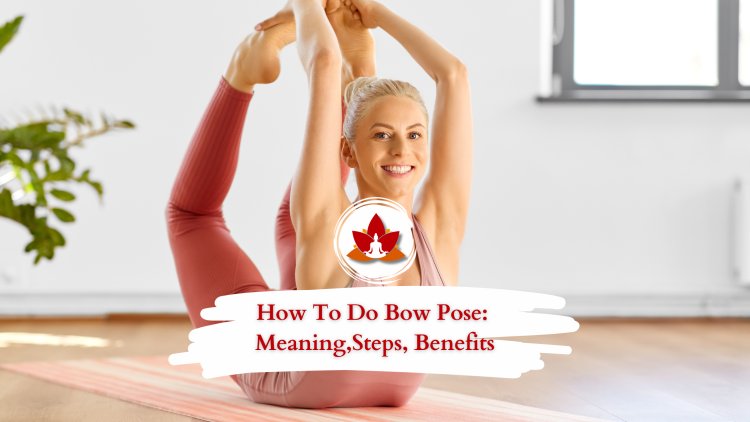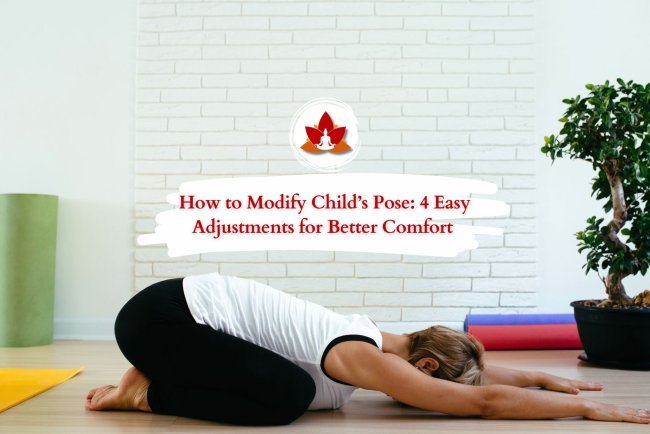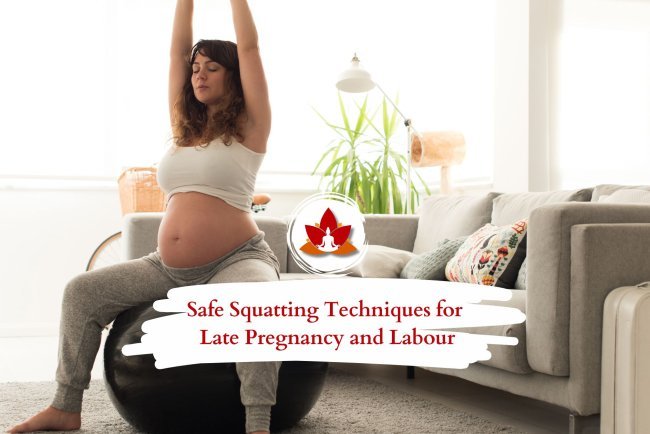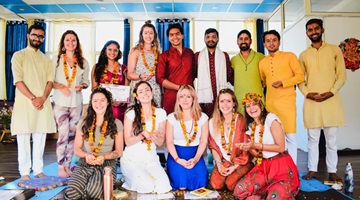How To Do Bow Pose: Meaning,Steps, Benefits

Bow pose known as Dhanurasana In Sanskrit, "Dhanurasana" combines "dhanur," which means bow, and "asana," means a posture.It can be pronounced as DHA-NUR-AAH-SUH-NA.
Brief idea of bow pose (Dhanurasana) :
The bow pose is a classic hatha yoga posture that offers multiple health benefits. It combines the flexibility and strength of a backbend with the balance and grounding making it a comprehensive asana for overall wellness. Under this pose, the body resembles a bow with limbs stretched out. It involves lying down on your stomach, grabbing the ankles, and slowly lifting the chest and thighs off the ground. This pose not only increases spine flexibility but also strengthens the back muscles and stretches the abdominal muscles.
This comprehensive guide takes you through everything you need to know about :
-
How to do bow pose from its benefits,
-
Contraindications
-
Step-by-step instructions
-
Variations and common mistakes to avoid.
How To Do Bow Pose: Step By Step
-
Start with lying on your belly, with your hands by your side, palms facing upwards.
-
Bend your knees and grab your ankles from outside with your hands.
-
Stay grounded with your pubic bone, draw your lower belly in and up.
-
Inhale, lift your chest up and move your ankles and thighs up and back.
-
Move your shoulder blades down and towards each other to open up your chest
-
Stay for a few breaths.
-
Exhale, release your ankles, and gently lie down on your belly for a few breaths.
-
As a counter pose you can do Balasana (Child pose). Stay here for 5 breaths.
5 Benefits Of Bow Pose
Bow Pose offers several benefits for the body and mind:
-
Improves Spinal Flexibility: Bow Pose stretches and strengthens the spine, improving flexibility and reducing stiffness.
-
Strengthens the muscles in your back: During Dhanurasana, by engaging the back muscles, including the erector spinae, this pose helps strengthen the entire back.
-
Boosts digestion: Bow pose massages the abdominal organs, improving digestion and promoting overall gastrointestinal health.
-
Opens the Chest and Shoulders: Dhanurasana expands the chest and shoulders, improving lung capacity and promoting better breathing.
-
Enhances Posture: Regular practice of Bow Pose helps correct rounded shoulders and promotes a more upright posture over time.
Contraindications Of Bow Pose
Avoid practicing bow pose, in the following cases:
-
Back or Neck Injury: Individuals who are suffering with current or chronic back or neck issues should avoid or modify this pose.
-
Recent Abdominal Surgery: Those recovering from recent abdominal surgery should avoid putting excessive strain on the abdominal muscles.
-
Pregnancy: During the pregnancy, Pregnant women should avoid deep backbends like Dhanurasana, especially in later stages of pregnancy, due to potential discomfort and risk to the fetus.
-
High Blood Pressure: People with hypertension should be careful with backbends, as these poses can elevate blood pressure.
-
Hernia: Dhanurasana should be avoided if you have a hernia particularly in the abdominal area.
Precaution :
Before trying Dhanurasana or any yoga pose, it's wise to consult your doctor or a qualified yoga instructor, especially if you have specific medical conditions or concerns.
Awareness in Dhanurasana
In Bow pose our physical awareness focuses on strengthening the back, along with slow and deep breaths.
While performing the bow pose, focus your spiritual awareness on solar plexus or third eye chakra energy centers.
Common Mistakes in Bow Pose
Incorrect Form:
-
Avoid lifting your shoulders towards your ears.
-
Make sure your knees do not spread outwards excessively.
Overstretching:
-
Do not force your legs or back beyond their natural range of motion.
Misalignment:
-
Keep your hips even to the floor to avoid twisting in your spine.
Bow Pose Variations
There are few variations of Bow Pose that offer different levels of intensity and benefits:
-
One-Legged Bow Pose (Eka Pada Dhanurasana): involves lifting one leg while maintaining the bow shape with your body, while the other leg remains grounded.
-
Saral Dhanurasana (Easy Bow Pose): In this variation of Dhanurasana, you lift your head, knee and chest slightly from the ground.
-
Ardha Dhanurasana (Half Bow Pose): In this variation of Bow pose, you raise the legs, head and chest as high as possible.
-
Purna Dhanurasana (Full Bow Pose): In this variation of Dhanurasana, you hold the toes of one foot only and twist the elbow outwards and upwards. Now, repeat the same with your other foot. Raise both hands above your head and grasp your toes. Hold this yoga pose for as long as you can while breathing normally, then release the pose slowly as you exhale.
Preparatory And Counter Poses For Dhanurasana
Preparations pose:
-
Shoulder rotations
-
Bridge pose
-
Cobra pose
-
Upward plank pose
-
Surya namaskar
Counter poses:
-
Child pose
-
Knee to the chest
-
Sitting bend forward
Conclusion
Dhanurasana, commonly known as the bow pose in yoga, provides a variety of physical, mental, and emotional health benefits. Numerous health benefits of bow pose make it a valuable component of any yoga practice. Bow pose enhances strength, flexibility, and balance while promoting mental and spiritual well-being. Whether you're new to yoga or an experienced yoga practitioner, Dhanurasana can be adjusted to suit your individual abilities and goals.
Embrace the beauty of bow pose. Enjoy its deep stretches, and discover the transformative effects of Dhanurasana on your yoga journey. Remember to practice this asana as we mentioned in this article. For beginners it's advisable to practice under the supervision of a qualified instructor for the best results!
Frequently Asked Questions For Dhanurasana
Q1. Are there any variations of Dhanurasana?
There are four different variations of Dhanurasana, which we had mentioned above. 1- One-Legged Bow Pose (Eka Pada Dhanurasana), 2- Saral Dhanurasana (Easy Bow Pose), 3- Ardha Dhanurasana (Half Bow Pose), 4- Purna Dhanurasana (Full Bow Pose)
Q2. Is Dhanurasana recommended for pregnant women?
It is not advisable to do Bow pose during pregnancy. Especially in later stages, as it involves lying on the abdomen and strong back bending which could be the cause of Miscarriage.
Q3. Which muscles are stretched in Dhanurasana?
Bow pose stretches your anterior deltoid, pectoralis major, rectus abdominis, front of your hips (hip flexors), and the front of your thighs (quadriceps).
Q4. Which muscles are strengthened in Dhanurasana?
Bow Pose strengthens your erector spinae,hamstrings, and buttocks (glutes).
Q5. What is the counter pose for Dhanurasana?
Child pose (Balasana) is a good counter pose for Dhanurasana.
Q6. is Dhanurasana good for pranayama practice?
Bow pose could be a very effective yoga pose for pranayama practitioners as it helps to open up your chest, which increases the capacity of your lungs. It may help you to breathe deeply.
Q7. What are the diseases that bow pose treats?
Although not a direct treatment, Bow Pose is effective in addressing issues such as PCOD/PCOS, asthma, rheumatic arthritis, digestive disorders, and migraines.
Q8. What is the time duration for holding Dhanurasana to gain the most advantages?
If you are a yoga beginner, 10 - 20 sec holding is good for you.
For intermediate yoga practitioners, 20- 40 sec holding is good.
For advanced practitioners , 40 - 60 sec is the best time to hold this pose.
Q9. Is Dhanurasana suitable for beginners?
As a beginner practitioner you can do saral dhanurasana(easy bow pose).
Q10. What are the benefits of Dhanurasana for posture?
Dhanurasana improves posture by strengthening the back muscles, opening the chest, and increasing spinal flexibility.
What's Your Reaction?


























